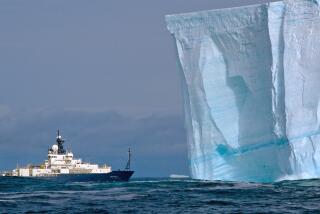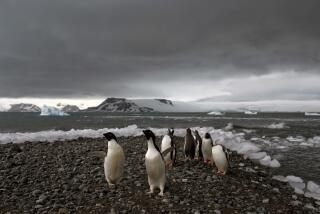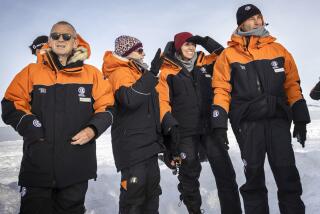The World Park Question
- Share via
ANTARCTICA IS a continent of extremes and contradictions. Nearly centered over the South Pole, it’s known as the coldest, windiest and driest place on earth. But the international environmental group Greenpeace contends that this harsh, foreboding place is also one of earth’s most fragile areas and wants to protect it by making it what it terms a world park.
The 5.1-million-square-mile continent has been protected since 1961 by an agreement signed by 12 nations with territorial or scientific interests. One provision of the Antarctic Treaty, up for review in 1991, delayed settlement of mineral and oil claims for 30 years.
But during the oil crisis of the early ‘70s, attention turned to potential Antarctic offshore reserves. There were estimates that about 45 billion barrels of oil might be found. At the same time, onshore surveys for coal, iron and uranium were conducted with encouraging results. Anticipating a battle for oil and mineral rights, the treaty’s 20 voting nations began negotiations in 1982.
The result was the Antarctic Mineral Resource Activity agreement, adopted in June, that would establish a system for dividing future rights. Although no drilling or prospecting is currently planned, the agreement, if ratified by 16 of the 20 countries by November, 1989, would regulate such activities.
Because of this, as part of its World Park concept, Greenpeace seeks a permanent ban on any type of mineral prospecting.
“Mining simply cannot occur without environmental degradation and damage,” says Paul Bogart of Greenpeace’s U.S. Antarctic campaign.
Just 2% of Antarctica is ice free; most of its land is buried beneath masses of snow and ice about a mile thick--almost 90% of all the ice on earth. Although little plant or animal life exists in the harsh conditions atop the enormous ice cap, Antarctica’s coastline and surrounding freezing waters are home to vast numbers of animal life: krill, seals, whales, fish, penguins, petrels and other marine birds. It is this fragile area that Greenpeace fears would be most threatened by an oil-well blowout.
The World Park idea also incorporates other basic premises of the original treaty: that the continent remain military free and that it continue as a zone of limited research activity. Greenpeace maintains a group of volunteers at World Park Base on Cape Evans in the McMurdo Sound to monitor adherence to the treaty.
Original signers of the Antarctic Treaty were the United States, the Soviet Union, Great Britain, France, Japan, Argentina, Chile, Belgium, Australia, New Zealand, Norway and South Africa; since then, 26 countries have joined the treaty, eight as voting members. Nineteen countries have set up 58 summer and winter scientific bases throughout Antarctica, experimenting mainly in astronomy, atmospheric pollution and glaciology.
Not all of these favor the Greenpeace proposal, however. “The World Park concept sounds nice,” says Tucker Scully, director of the U.S. State Department’s Office of Oceans and Polar Affairs. “But we already have a treaty in place that has been successful. There’s no sense among the full participant nations that we need another agreement such as the one Greenpeace is advocating. But there’s also no question that when there is human activity where there has been none, monitoring is necessary. We see Greenpeace as legitimate observers to this activity, and they don’t cause us any problems at all.”
More to Read
Sign up for Essential California
The most important California stories and recommendations in your inbox every morning.
You may occasionally receive promotional content from the Los Angeles Times.













